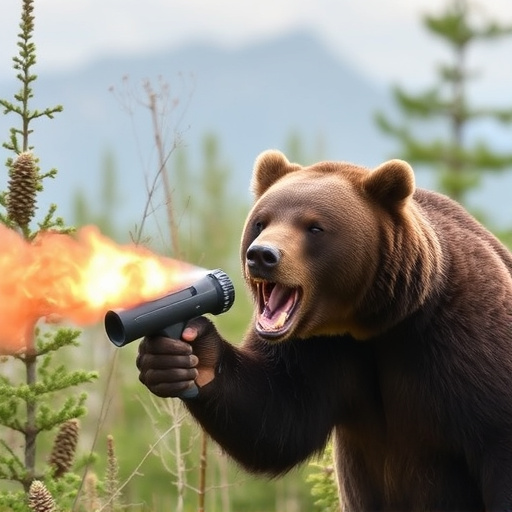Grizzly bear encounters in the wild can be daunting, but understanding their charging behaviors and using bear spray effectively is key to survival. The optimal distance for deploying bear spray is 20-30 feet (6-9 meters), allowing users to target the bear's face while maintaining safety. This tactic irritates the bear's sensitive areas, temporarily disorienting it and providing humans with an escape window. Proper training, considering wind, terrain, and bear behavior, ensures successful usage, enhancing outdoor enthusiasts' safety in bear country. Combining spray with other deterrents like noise-making tools and secure food storage can significantly reduce risk during encounters.
In the vast wilderness, encountering a charging grizzly bear is a terrifying yet common reality. Understanding their behavior and having the right defense mechanisms can mean the difference between safety and tragedy. This article delves into effective strategies against aggressive bears, focusing on the crucial role of bear spray and the optimal distance for its use. We explore behavioral patterns, additional defenses, and expert tips to empower adventurers in navigating these potent encounters.
- Understanding Grizzly Bear Behavior and Their Charging Patterns
- The Role of Bear Spray in Wilderness Safety
- Determining the Optimal Distance for Effective Bear Spray Use
- Additional Measures to Enhance Your Defense Against Charging Bears
Understanding Grizzly Bear Behavior and Their Charging Patterns
Grizzly bears are powerful animals with a reputation for aggression, especially when they feel threatened or are protecting their cubs. Understanding their behavior and charging patterns is crucial for anyone venturing into bear country. Research suggests that grizzlies have distinct charging behaviors depending on the situation. Often, they charge as a form of intimidation to scare off perceived threats, a tactic known as ‘bellowing’ where they emit loud noises while running. This behavior usually ends once they assess the danger has passed.
When it comes to defense against charging bears, maintaining a safe distance is vital. The optimal distance for bear spray, one of the primary deterrents, is generally recommended as 20-30 meters (65-100 feet). This allows for enough time to deploy the spray effectively while providing a buffer zone. Knowing these patterns and keeping a keen awareness of your surroundings can significantly enhance your safety in potential bear encounters.
The Role of Bear Spray in Wilderness Safety
In the vast wilderness, encountering a grizzly bear can be a frightening prospect, but armed with the right tools, hikers and campers can enhance their safety significantly. One such crucial tool is bear spray, designed to deter and disperse aggressive bears. The optimal distance for using bear spray effectively ranges from 20 to 30 feet (6 to 9 meters), making it a valuable defense mechanism when facing an approaching bear. This range allows users to deploy the spray accurately while maintaining a safe distance, as close encounters with bears can be extremely dangerous.
Bear spray creates a cloud of irritants that temporarily incapacitate the bear, providing precious time for escape or retreat. It’s essential to understand the proper usage techniques and ensure the spray is directed towards the bear’s face and eyes, as this area is highly sensitive. Regular training and familiarization with these defense mechanisms are vital for outdoor enthusiasts navigating bear country, promoting a safer and more enjoyable wilderness experience.
Determining the Optimal Distance for Effective Bear Spray Use
When facing a charging grizzly bear, understanding the optimal distance for effective bear spray use can be a matter of survival. The recommended range for bear spray is typically between 20 to 30 feet (6 to 9 meters). This distance allows you to deploy the spray directly into the bear’s face while keeping yourself out of its reach. It’s crucial to follow the instructions on the spray canister regarding spray pattern and direction, ensuring maximum coverage at this optimal range.
Several factors influence the effective distance, including wind conditions, terrain, and the bear’s behavior. In open areas, you may be able to use the spray from farther away, but in tight spaces like valleys or dense brush, the bear can quickly close the gap. Practicing with bear spray before encountering a real threat is essential to gauge its reach and effectiveness, ensuring you’re prepared to defend yourself at the optimal distance.
Additional Measures to Enhance Your Defense Against Charging Bears
When faced with a charging grizzly bear, your primary defense is often your awareness and quick thinking. However, there are additional measures you can take to enhance your safety in bear country. One crucial tool in your arsenal is bear spray—but understanding its effectiveness and proper usage is key. The optimal distance for applying bear spray is around 20 to 30 feet (6 to 9 meters). At this range, the spray can create a barrier that deters the bear by irritating its eyes and respiratory system. It’s important to remember that bear spray is not a guaranteed solution; it works best as a deterrent when combined with other defensive strategies.
Additionally, carrying a reliable backup tool like a bear bell or a loud whistle can provide an early warning system, giving you precious time to assess your surroundings and decide on the next course of action. Always ensure your food is stored securely in bear-resistant containers, and make noise while walking through dense areas to reduce the risk of surprising a bear. Staying calm, assessing the bear’s behavior, and using these defensive measures collectively can significantly improve your chances of escaping an encounter with minimal harm.
In conclusion, understanding grizzly bear behavior and employing effective strategies like responsible bear spray usage at the optimal distance can significantly enhance wilderness safety. While no method is foolproof, a combination of knowledge, preparation, and quick thinking can help minimize risks when encountering these powerful animals in their natural habitat. Always remember that prevention and awareness are key to ensuring safe interactions with bears in the wild.
